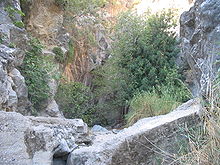- Myrtos
-
Myrtos is a coastal village in the west of the municipality of Ierapetra, in the prefecture of Lasithi on the island of Crete in Greece. It is located 14.5 km (9.0 mi) from Ierapetra, the most southern town of Europe and 50.5 km (31.4 mi) from Agios Nikolaos, on the road to Viannos. Myrtos is situated at the Libyan Sea. The population of the village in 2010 is about 600 people.
Myrtos has a rich history, and although many think it is a poor town it has prospered with the advent of tourism. The town (village) is full of tavernas although there is also a little jewellery shop, 2 supermarkets, a few souvenir shops and a bakery. There are a few hotels, apartments and studios.
Contents
History
The area surrounding Myrtos was already inhabited in the Minoan period, but the current village dates from the first half of the twentieth century. Before that it was the location of a small port, where inhabitants from higher surroundings traded for local products, which they shipped to Ierápetra. Only when threats from piracy along the Cretan coast diminished and it became safer to live there did the village of Myrtos develop.
On September 15, 1944, during the Second World War, the occupants of Myrtos were ordered by the German occupiers to leave the village. Many refused to do so, resulting in the massacre of eighteen inhabitants as a reprisal, and the almost complete destruction of the village by fire. In the central square of Myrtos there is a monument to commemorate that event. Near this monument, every year on October 28, Ohi Day is commemorated.
Tourism started at the beginning of the 1970s. Initially Myrtos was especially popular amongst hippies, but later also 'regular' tourists started to visit the village. Since the 1980s some apartment complexes have been built in Myrtos, but tourism in Myrtos is still relatively small-scale and nowhere near as developed as the tourist centres which one finds, for example, on the North coast of Crete.
Climate
Myrtos has a subtropical climate. The temperature in the south of Crete is a couple of degrees higher than in the north, because colder winds from the north are blocked by Dikti mountain (whose highest point is 2,150 metres or 7,050 feet).
The average temperature in the warmest months of the year (July and August) is around 30 degrees Celsius (85 °F), though sometimes it can exceed 40 degrees Celsius (105 °F). The temperature in the coldest months of the year (January and February) averages about 8 degrees Celsius (46 °F), and it can also sporadically snow in Myrtos.
The beaches
Myrtos has a long beach, consisting not just of sand, but also of finely grained pebbles. The beach has received the "Blue Flag award", which requires the beach to satisfy a number of criteria in order to retain it. The nearby village of Tertsa has a very long beach. On the two outlying beaches of Tertsa nudism is tolerated by the authorities.
Points of interest
Myrtos is also the location for two Minoan archaeological sites, at Fournou Korifi and Pyrgos, which provide evidence that the village and its environs have been inhabited since the neolithic period. There is also a Roman villa, although the ruins are now largely covered or lost due to coastal erosion and local building.
In Myrtos is a small museum, dedicated to the local history, which features a scale model of Fornou Korifi created by John Atkinson, a British potter resident in the village who is the current Museum Curator. Near the small village Mithi, about 3 miles (5 km) from Myrtos lies the Sarakina Gorge.
Economy
Of particular importance in increasing the prosperity around Myrtos in the middle of the twentieth century was the Dutchman Paul Kuijpers. After his studies in Holland, he moved to Crete in 1966 and introduced greenhouses in the southern part of the island, as a result of which farmers could harvest several times a year instead of only once. The areas surrounding Myrtos are still dominated by greenhouses, often composed only of wooden frames covered with plastic. In 1971, Paul Kuijpers was killed in a car accident, and a memorial in Gra Lighia commemorates his importance for the area.
In 2010 the prefecture of Lasithi is the most prosperous part of Crete.
External links
Coordinates: 35°00′13″N 25°35′04″E / 35.00361°N 25.58444°E
Municipal unit of Ierapetra Municipal unit of Makry Gialos Agios Stefanos · Chrysopigi · Lithines · Oreino · Pefkoi · Perivolakia · Schinokapsala · StavrochoriCategories:- Populated places in Lasithi
- Ierapetra
Wikimedia Foundation. 2010.





